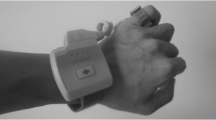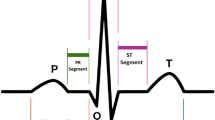Abstract
In recent years, the number of patients with hypertension is increasing, but the early symptoms of hypertension are not obvious, the incubation period is long, and the awareness rate and control rate are very low. Therefore, it is necessary to study the early recognition of hypertension in a non-clinical environment. The blood pressure of human being is controlled by autonomic nervous system, and heart rate variability (HRV) is an impact of autonomic nervous system and an indicator of the balance of cardiac sympathetic nerve and vagus nerve. So HRV is good method to recognize the hypertensive patients from healthy person. In this paper, we proposed a fined-grained HRV analysis method to recognize hypertensive patients from healthy person. Specifically, we cut the 8 h of ECG data into 5 min segments at first, and then we propose an improved heartbeat interval extraction algorithm to extract the heartbeat interval from Electrocardiogram (ECG) data and we extract 22 HRV features in linear, nonlinear domain and histogram, Specially, we model the distribution of the heartbeat interval of each time window using a Gaussian mixture model. Next we analyzed the correlation between linear domain and nonlinear domain features of heart rate variability. Finally, we use common machine learning algorithms to train a recognition model for hypertension. In this paper, we use 138 hypertension patients’ and 138 healthy person real-world clinical Electrocardiogram data as our data set. The recognition precision rate for patients with hypertension is 97.1%, and the recall rate is 97.1%. The experimental results validate the effectiveness and reliability of the proposed recognition method in this research.











Similar content being viewed by others
References
Boureau Y, Ponce J, LeCun Y (2010) A theoretical analysis of feature pooling in visual recognition. ICML
Carek A, Holz C (2018) Naptics: Convenient and continuous blood pressure monitoring during Sleep. Proc ACM Interact Mob Wearable Ubiquitous Technol 2(3):96. https://doi.org/10.1145/3264906
Carek AM, Conant J, Joshi A, Kang H, Inan OT (2017) SeismoWatch: wearable cufess blood pressure monitoring using pulse transit time. Proc ACM Interact Mob Wearable Ubiquitous Technol 1(3):1–16. https://doi.org/10.1145/3130905 (Article 40)
Chen Y, Chen W, Kitamura K, Nemoto TT, Guiyun (2016) Long-term measurement of maternal pulse rate dynamics using a home-based sleep monitoring system. J Sens. https://doi.org/10.1155/2016/5730142
Clifford GD, Tarassenko L (2002) Signal processing methods for heart rate variability. University of Oxford, Oxford
Coccagna G, Lugaresi E (1978) Arterial blood gases and pulmonary and systemic arterial pressure during sleep in chronic obstructive pulmonary disease. Sleep 1(2):117–124
Costa T, Boccignone G, Ferraro MB, Jérémie (2012) Gaussian mixture model of heart rate variability. PLoS One 7(5):e37731
Couderc JP, Xiaojuan X, Zareba W, Moss AJ (2005) Assessment of the stability of the individual-based correction of QT interval for heart rate. Ann Noninvasive Electrocardiol 10(1):25–34
DataBase (2015) https://physionet.org/physiobank/database/shareedb/
Davies RJO, Jenkins NE, Stradling JR (1994) Effect of measuring ambulatory blood pressure on sleep and on blood pressure during sleep. BMJ 308(6932):820–823
Fletcher EC, Levin DC (1984) Cardiopulmonary hemodynamics during sleep in subjects with chronic obstructive pulmonary disease: the effect of short-and long-term oxygen. Chest 85:6–14
France S, Miroljub J (2002) Heart rate variability—a shape analysis of Lorenz plots. Cell Mol Biol Lett 7(1):159–161
Information_Entropy (2002) https://en.wikipedia.org/wiki/Entropy_(information_theory)
Kiranyaz S, Ince T, Gabbouj M (2016) Real-time patient-specific ECG classification by 1-D convolutional Neural Networks. IEEE Trans Biomed Eng 63(3):664–675
Kullback S (1959) Information theory and statistics[M]. Wiley, Hoboken
Li W, Gu H, Teo KK, Bo J, Wang Y, Yang J, Wang X, Zhang H, Sun Y, Jia X et al (2016) Hypertension prevalence, awareness, treatment, and control in 115 rural and urban communities involving 47000 people from China. J Hypertens 34(1):39–46
Liu T, Fang S, Zhao Y et al (2015) Implementation of training convolutional neural networks. arXiv preprint arXiv:1506.01195
Mustaffa Z, Yusof Y (2011) A comparison of normalization techniques in predicting. 2010 international conference on business and economics research, vol 1. IACSIT Press, Kuala Lumpur
NCD Risk Factor Collaboration (NCD-RisC) (2016) Worldwide trends in blood pressure from 1975 to 2015: a pooled analysis of 1479 population-based measurement studies with 19·1 million participants. Lancet 2017(389):37–55. https://doi.org/10.1016/S01406736(16)31919-5
Ni H, Cho S, Mankoff J, YangDey JAK (2017) Automated recognition of hypertension through overnight continuous HRV monitoring. J Ambient Intell Human Comput. https://doi.org/10.1007/s12652-017-0471-y
Ni H, Wang Y, Xu G, Shao Z, Zhang W, Zhou X (2019) Multiscale fine-grained heart rate variability analysis for recognizing the severity of hypertension. Comput Math Methods Med 2019:1–9. https://doi.org/10.1155/2019/4936179 (Article ID 4936179)
Patro SGK, Sahu KK (2015) Normalization: a preprocessing stage. arXiv:1503.06462
Poddar MG, Kumar V, Sharma YP (2014) Heart rate variability based classifcation of normal and hypertension cases by linear-nonlinear method. Def Sci J 64(6):542–548. https://doi.org/10.14429/dsj.64.7867
Romanuke Vadim V (2017) Appropriate number of standard 2×2 max pooling layers and their allocation in convolutional neural networks for diverse and heterogeneous datasets. Inf Technol Manag Sci 20(1):12–19
Rui W, Weichen W, Alex D, Jeremy H, William K, Todd H, Andrew C (2018) Tracking depression dynamics in college students using mobile phone and wearable sensing. Proc ACM Interact Mob Wearable Ubiquitous Technol 2(1):1–26
Schroeder B, Emily LE, Duanping CJ, Lloyd PW, Ronald EW, Gregory HW, Gerardo R (2003) Hypertension, blood pressure, and heart rate variability the atherosclerosis risk in communities (ARIC) study. Hypertension 42(6):1106–1111
Song Y, Ni H, Zhou X, Zhao W, Wang T (2015) Extracting Features for Cardiovascular Disease Classification Based on Ballistocardiography. In: 2015 IEEE 12th intl conf on ubiquitous intelligence and computing and 2015 IEEE 12th intl conf on autonomic and trusted computing and 2015 IEEE 15th intl conf on scalable computing and communications and its associated workshops (UIC-ATC-ScalCom), pp 1230–1235. https://doi.org/10.1109/UIC-ATC-ScalCom-CBDCom-IoP.2015.223
Van Oosterom A (2009) Measuring the T wave of the electrocardiogram; the how and why. Measur Sci Rev 9(3):53
Wang T, Wang Z, Zhang D, Gu T, Ni H, Jia J, Zhou X, Lv J (2016) Recognizing Parkinsonian Gait pattern by exploiting fine-grained movement function features[J]. ACM Trans Intell Syst Technol 8(1):6
Wen W (2012) The status quo and countermeasures of hypertension prevention and treatment in China[J]. J Med Res 41(5):3–5
Wiens AD, Johnson A, Inan OT (2017) Wearable sensing of cardiac timing intervals from cardiogenic limb vibration signals. IEEE Sens J 17:1463–1470. https://doi.org/10.1109/JSEN.2016.2643780
Xiaonan G, Jian L, Cong S, Hongbo L, Yingying C, Mooi CC (2018) Device-free personalized fitness assistant using WiFi. Proc ACM Interact Mob Wearable Ubiquitous Technol 2(4):1–23. https://doi.org/10.1145/3287043 (Article 165)
Zheng Y, Yan BP, Zhang Y, Yu CM, and Poon CCY (2013) Wearable cuff-less PTT-based system for overnight blood pressure monitoring. In: 2013 35th Annual International Conference of the IEEE Engineering in Medicine and Biology Society (EMBC). pp 6103–6106. https://doi.org/10.1109/EMBC.2013.6610945
Zhou Z (2016) Machine learning. Tsinghua University Press, Beijing (ISBN 978-7-302-42328-7)
Acknowledgements
We thank the reviewers for the valuable comments and spending time towards the improvement of the paper. Meanwhile, we should also thank the subjects to help us conduct the presented experiments. This work is supported by State Key Program of National Natural Science of China (No. 61332013).
Author information
Authors and Affiliations
Corresponding author
Additional information
Publisher's Note
Springer Nature remains neutral with regard to jurisdictional claims in published maps and institutional affiliations.
Rights and permissions
About this article
Cite this article
Ni, H., Li, Z., Shao, Z. et al. RecogHypertension: early recognition of hypertension based on heart rate variability. J Ambient Intell Human Comput 13, 3945–3962 (2022). https://doi.org/10.1007/s12652-021-03492-3
Received:
Accepted:
Published:
Issue Date:
DOI: https://doi.org/10.1007/s12652-021-03492-3




